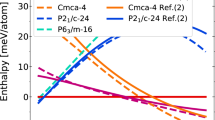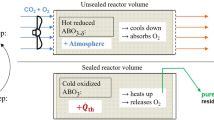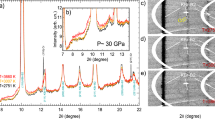Abstract
THE barium oxide–carbon, dioxide system has been examined at pressures of carbon dioxide up to 450 atm.1 and is similar in many respects to that of calcium oxide and carbon dioxide2. To bring out the salient features in the eutectic region the section of the diagram shown in Fig. 1 has been restricted to pressures up to 1 atm. Schematic portions are shown as broken lines.
This is a preview of subscription content, access via your institution
Access options
Subscribe to this journal
Receive 51 print issues and online access
$199.00 per year
only $3.90 per issue
Buy this article
- Purchase on Springer Link
- Instant access to full article PDF
Prices may be subject to local taxes which are calculated during checkout
Similar content being viewed by others
References
Baker, E. H., J. Chem. Soc., 699 (1964).
Baker, E. H., and Butler, J., Nature, 195, 173 (1962).
Hackspill, L., and Wolff, C., C.R. Acad. Sci., Paris, 204, 1820 (1937).
Lander, J. J., J. Amer. Chem. Soc., 73, 5893 (1951).
Baker, E. H., J. Chem. Soc., 339 (1963).
Author information
Authors and Affiliations
Rights and permissions
About this article
Cite this article
BAKER, E. A Phase Diagram for the Barium Oxide–Carbon Dioxide System in the Eutectic Region. Nature 206, 1250–1251 (1965). https://doi.org/10.1038/2061250a0
Issue Date:
DOI: https://doi.org/10.1038/2061250a0
This article is cited by
-
Thermodynamics of sulfur in BaO-CaO-CO2 system
Metallurgical Transactions B (1993)
Comments
By submitting a comment you agree to abide by our Terms and Community Guidelines. If you find something abusive or that does not comply with our terms or guidelines please flag it as inappropriate.



